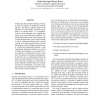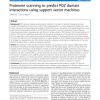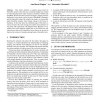13 search results - page 1 / 3 » Target Word Detection and Semantic Role Chunking using Suppo... |
NAACL
2003
13 years 6 months ago
2003
In this paper, the automatic labeling of semantic roles in a sentence is considered as a chunking task. We define a semantic chunk as the sequence of words that fills a semantic...
BMCBI
2010
13 years 4 months ago
2010
Background: PDZ domains mediate protein-protein interactions involved in important biological processes through the recognition of short linear motifs in their target proteins. Tw...
WWW
2007
ACM
14 years 5 months ago
2007
ACM
Semantic similarity measures play important roles in information retrieval and Natural Language Processing. Previous work in semantic web-related applications such as community mi...
EMNLP
2009
13 years 2 months ago
2009
We present a framework to extract the most important features (tree fragments) from a Tree Kernel (TK) space according to their importance in the target kernelbased machine, e.g. ...
ECAI
2006
Springer
13 years 8 months ago
2006
Springer
This article describes a semantic parser based on FrameNet semantic roles that uses a broad knowledge base created by interconnecting three major resources: FrameNet, VerbNet and P...



